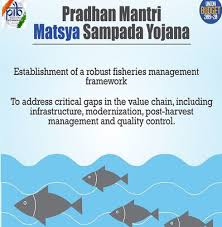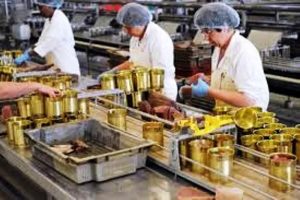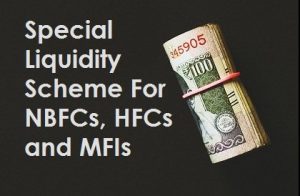Table of Contents
Daily Current Affairs for Government Exams:
Today Current Affairs:21st May 2020 for UPSC IAS exams, State PSC exams, SSC CGL, State SSC, RRB, Railways, Banking Exam & IBPS, etc.
Contents:
- Pradhan Mantri Matsya Sampada Yojana (PMMSY)
- The formalization of Micro Food Processing Enterprises:
- Emergency Credit Line Guarantee Scheme (ECLGS) for MSMEs and MUDRA borrowers.:
- SpaceX Demo-2
- Special Liquidity Scheme For NBFCs/HFCs
- Pradhan Mantri Vaya Vandana Yojana (PMVVY)
- Other important current affairs
1. Pradhan Mantri Matsya Sampada Yojana (PMMSY) :

Recently, the Cabinet has approved the implementation of the Pradhan Mantri Matsya Sampada Yojana (PMMSY)
- The Pradhan Mantri Matsya Sampada Yojana (PMMSY) was first mentioned during the 2019-20 Budget.
- It aims to bring a blue revolution through the sustainable and responsible development of the fisheries sector in India.
- It also intends to augment fish production and productivity at an annual growth rate of 9% to achieve a target of 22 million metric tons by 2024-25.
- It strives to create direct employment to 15 lakh fishers, fish farmers, etc. and about thrice this number as indirect employment opportunities.
- It also aims to double the incomes of fishers, fish farmers and fish workers by 2024.
- Time Period: The Scheme will be implemented during a period of 5 years from the Financial Year (FY) 2020-21 to FY 2024-25.
- Funding: It has a total estimated investment of Rs 20,050 crore. The investment share is segregated as:
- Central Share: Rs 9,407 crores.
- States’ Share: Rs 4,880 crores.
- Beneficiaries’ Share: Rs 5,763 crores.
- Implementation: The PMMSY will be implemented as an umbrella scheme with two separate Components namely,
- Central Sector Scheme (CS):
- Non-beneficiary Oriented: The entire project cost will be borne by the Central government (i.e. 100% central funding).
- Beneficiary Oriented: The individual/group activities undertaken by the entities of central government including the National Fisheries Development Board (NFDB), the central assistance will be up to 40% of the project cost for General category and 60% for SC/ST/Women category.
- Central Sector Scheme (CS):
2.The formalization of Micro Food Processing Enterprises:

- Aim: The Scheme for Formalisation of Micro Food Processing Enterprises (FME) intends to increase access to finance and revenue targets for the micro food processing enterprises.
- It also targets 2,00,000 micro-enterprises to be assisted with credit-linked subsidies.
- It envisages increased access to credit by existing micro food processing entrepreneurs, women entrepreneurs, and entrepreneurs in the Aspirational Districts.
- The project is likely to generate 9 lakh skilled and semi-skilled jobs.
- It will also help to integrate micro food processing enterprises with the organized markets.
Features:
- It is a Centrally Sponsored Scheme (CSS) on All India basis with an outlay of Rs. 10,000 crore.
- The expenditure will be shared by the Centre and the States in a ratio of 60:40.
- The scheme will be implemented over a 5 year period from 2020-21 to 2024-25.
- The Scheme will majorly focus on perishables.
- The Scheme would be monitored at Centre by an Inter-Ministerial Empowered Committee (IMEC) under the Chairmanship of Food Processing Industries Minister.
- A State/UT Level Committee (SLC) chaired by the Chief Secretary will monitor and sanction/recommend proposals for expansion of micro-units and setting up of new units by the Self Help Groups (SHGs)/Farmer Producer Organizations (FPOs)s/ Cooperatives.
- The Scheme also envisages the third party evaluation and mid-term review mechanism in the program.
3. Emergency Credit Line Guarantee Scheme (ECLGS) for MSMEs and MUDRA borrowers.:

The Union Cabinet has given its approval for the Emergency Credit Line Guarantee Scheme (ECLGS) for MSMEs and MUDRA borrowers.
- Under the Scheme, 100% guarantee coverage to be provided by National Credit Guarantee Trustee Company Limited (NCGTC) for additional funding of up to Rs. 3 lakh crore to eligible MSMEs and interested MUDRA borrowers.
- The credit will be provided in the form of a Guaranteed Emergency Credit Line (GECL) facility.
- The Scheme would be applicable to all loans sanctioned under the GECL Facility during the period from the date of announcement of the Scheme to 31.10.2020.
- The tenor of the loan under Scheme shall be four years with a moratorium period of one year on the principal amount.
- No Guarantee Fee shall be charged by NCGTC from the Member Lending Institutions (MLIs) under the Scheme.
Interest rates under the Scheme shall be capped at 9.25% for banks and FIs, and at 14% for NBFCs.
Benefits of the scheme: - The scheme aims to mitigate the distress caused by COVID-19 and the consequent lockdown, which has severely impacted manufacturing and other activities in the MSME sector.
- The scheme is expected to provide credit to the sector at a low cost, thereby enabling MSMEs to meet their operational liabilities and restart their businesses.
- By supporting MSMEs to continue functioning during the current unprecedented situation, the Scheme is also expected to have a positive impact on the economy and support its revival.
4.SpaceX Demo-2 :

On May 27, 2020, NASA’s SpaceX Demo-2 test flight will lift off for International Space Station (ISS), becoming the first crewed flight to launch from American soil since the conclusion of the space shuttle era in 2011.
- The Demo-2 mission is part of NASA’s Commercial Crew Program and will see astronauts Robert Behnken and Douglas Hurley fly on SpaceX’s Crew Dragon spacecraft. The craft will lift off from a Falcon 9 rocket, from Florida.
- NASA’s Commercial Crew Program has worked with several American aerospace industry companies to facilitate the development of US human spaceflight systems since 2010, with the aim of developing reliable and cost-effective access to and from the ISS.
- Essentially, the lift-off on May 27 is a flight test to certify if SpaceX’s crew transportation system can be used to ferry crew to and from the space station regularly.
- This is the final flight test for the system and intends to validate its different components, including the spacecraft (Crew Dragon), the launch vehicle (Falcon 9), the launch pad (LC-39A), and the operations capabilities.
- After its launch, the Crew Dragon will perform a series of phasing maneuvers to gradually approach and autonomously dock with the ISS on May 28. After docking, the two astronauts will go aboard the ISS.
6.Special Liquidity Scheme For NBFCs/HFCs:

The Union Cabinet has approved the proposal of the Ministry of Finance to launch a new Special Liquidity Scheme for Non-Banking Financial Companies (NBFCs) and Housing Finance Companies (HFCs) to improve the liquidity position of the NBFCs/HFCs.
- A large public sector bank would set up a Special Purpose Vehicle (SPV) to manage a Stressed Asset Fund (SAF) whose special securities would be guaranteed by the Government of India and purchased by the Reserve Bank of India (RBI) only.
- The SPV would issue securities as per requirement subject to the total amount of securities outstanding not exceeding Rs. 30,000 crore to be extended by the amount required as per the need.
- The securities issued by the SPV would be purchased by RBI and proceeds thereof would be used by the SPV to acquire the debt of at least investment grade of short duration (residual maturity of up to 3 months) of eligible NBFCs / HFCs.
- The Scheme will be administered by the Department of Financial Services.
- The direct financial implication for the Government is Rs. 5 crores, which may be the equity contribution to the Special Purpose Vehicle (SPV).
7. Pradhan Mantri Vaya Vandana Yojana (PMVVY) :

The Union Cabinet has given its approval to the Extension of Pradhan Mantri Vaya Vandana Yojana (PMVVY) and other changes for the welfare of and to enable old age income security for Senior Citizens.
Changes for the Welfare of the aged:
- Extension of Pradhan Mantri Vaya Vandana Yojana (PMVVY) up to 31st March 2023.
- Revised rate of returns of the Senior Citizens Saving Scheme (SCSS).
- Approval for expenditure to be incurred on account of the difference between the market rate of return generated by LIC.
- The minimum investment has also been revised to Rs.1,56,658 for a pension of Rs.12,000/- per annum and Rs.1,62,162/- for getting a minimum pension amount of Rs.1000/- per month under the scheme.
About PMVVY:
- It is a Pension Scheme exclusively for the senior citizens aged 60 years and above.
- The Scheme can be purchased offline as well as online through Life Insurance Corporation (LIC) of India which has been given the sole privilege to operate this Scheme.
- Maximum investment: One can invest a maximum amount of ₹15 lakh under the Pradhan Mantri Vaya Vandana Yojana (PMVVY) scheme. The tenure of the policy is set at 10 years.
- The scheme provides initially an assured rate of return of 7.40 % per annum for the year 2020-21 per annum and thereafter to be reset every year.
- Pension is payable at the end of each period, during the policy term of 10 years, as per the frequency of monthly/ quarterly/ half-yearly/ yearly as chosen by the pensioner at the time of purchase.
- The scheme is exempted from GST.
- On survival of the pensioner to the end of the policy term of 10 years, Purchase price along with final pension installment shall be payable.
- Loan up to 75% of Purchase Price shall be allowed after 3 policy years (to meet the liquidity needs). Loan interest shall be recovered from the pension installments and loan to be recovered from claim proceeds.
- The scheme also allows for premature exit for the treatment of any critical/ terminal illness of self or spouse. On such a premature exit, 98% of the Purchase Price shall be refunded.
- On the death of the pensioner during the policy term of 10 years, the Purchase Price shall be paid to the beneficiary.
Other important current affairs:
1. Amendments to General Financial Rules (GFR) :
- The government has notified amendments to General Financial Rules (GFR) to ensure that goods and services valued less than 200 crore rupees are being procured from domestic firms.
- Center has notified the amendments to the GFR 2017 to ensure that henceforth global tenders will be disallowed in government procurement up to 200 crore rupees, as announced in the Aatmanirbhar Bharat Package.
- It is a big boost to domestic suppliers especially micro, small, and medium enterprises (MSMEs).
- Last week, the Union Finance Minister had announced an economic support package MSMEs, which includes disallowing global tender for government procurement up to 200 crore rupees.
2. The Ministry of New and Renewable Energy (MNRE) has taken up the Complete Solarisation of Konark sun temple and Konark town in Odisha.
- The Scheme envisages setting up 10 MW grid-connected solar projects and various solar off-grid applications like solar trees, solar drinking water kiosks, off-grid solar power plants with battery storage, etc.
- The Project will be taken up with a 100% Central Financial Assistance (CFA) support of around Rs. 25 Crores from Government of India through the Ministry of New & Renewable Energy (MNRE).
- The implementation of this project will be done by the Odisha Renewable Energy Development Agency (OREDA).
- The Scheme will meet all the energy requirements of Konark town with solar energy.
3. The government of India announced the commercial launch of Agappe Chitra Magna.
- Agappe Chitra Magna is a magnetic nanoparticle-based RNA extraction kit for use during testing for the detection of COVID-19.
- It was developed by the Sree Chitra Tirunal Institute for Medical Sciences and Technology (SCTIMST), Trivandrum, an Institute of National Importance of the Department of Science and Technology (DST) along with Agappe Diagnostics Ltd, an in vitro diagnostics manufacturing company based in Cochin.
- The commercial launch of the kit can help increase the rate of testing and bring down its costs, a crucial step for combating the pandemic.
5.China’s May Fourth Movement
- It is an intellectual revolution and sociopolitical reform movement that occurred in China on May 4th in 1919.
- The Movement unfolded sparked by the refusal of delegates at the Paris Peace Conference to return former German colonies in China to Chinese sovereignty at the conclusion of World War I.
- The students protested not only Western imperialism but their own government’s weakness.
6.‘Sonic Boom
- A sonic boom is said to occur when an object travels through the air faster than the speed of sound and creates shock waves.
- This can lead to a huge emission in energy, usually in the form of sound, which can be similar to an explosion or a thunderclap.
- The sonic boom is a continuous sound that is emitted by the aircraft all the while it is traveling at a supersonic speed.
- If the aircraft is flying at a low altitude, the sonic boom may also lead to tremors similar to earthquakes and shattering of glass.
6. The Indian Institute of Technology-Guwahati (IIT-G) have found methods for preventing the accumulation of neurotoxic molecules in the brain, which leads to Alzheimer’s disease.
- The cause of Alzheimer’s is the accumulation of amyloid-beta peptides (neurotoxic molecules) in the brain.
- The peptide is similar to the plaque that blocks arteries and affects blood supply, leading to cardiovascular diseases.
- Peptide aggregation/accumulation means their formation of one over the other, deforming the cortex of the brain which leads to Alzheimer’s.
- The peptide molecules need to have a certain structure to aggregate.
- Preventive Methods:
- Use of Trojan Peptides:
- In this approach, the purpose is to design a deceitful peptide with “negative syncretical points” for checking the plaque formation.
- Trojan peptide (deceitful peptide) has the same structure as the peptide in the body but its function is contrary to aggregation.
- Use of Trojan Peptides:
7. The Haryana government has launched the ‘H1N1 Vaccination Campaign for Healthcare Workers’ and Hepatitis-B control program.
- H1N1 Vaccination Campaign for Healthcare Workers
- India usually witnesses two peaks of H1N1 infection, one from January to March and another in post Monsoon between August and October.
- Thus, precautions through vaccination for H1N1 is considered to be a better solution.
- The health workers are already facing the risk of Covid-19 while managing the pandemic, hence focussing on their health safety has become a top priority for the government.
- In India, since 2016 about 85,000 persons are being infected by the H1N1virus and 4,900 deaths have occurred in the last few years.
8. The first International Tea Day (ITD) is being celebrated by the United Nations on 21 May.
- International Tea Day is observed annually on May 21, according to the United Nations.
- The concerning resolution was adopted on December 21, 2019, and calls on the United Nations Food and Agriculture Organization (FAO) to lead the observance of the Day.
- The Day aims to raise awareness of the long history and the deep cultural and economic significance of tea around the world.




